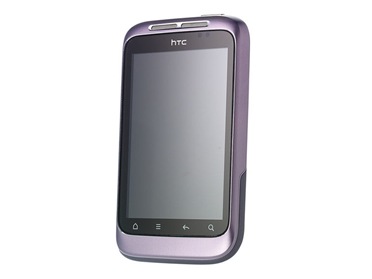HTC’s original Wildfire offered a full-fat Android experience in a budget handset, and was a PC Pro favourite for a while. But as more powerful phones dropped in price – notably the 1GHz Snapdragon-based HTC Desire – our fondness for the Wildfire waned. Its successor, the Wildfire S, aims to reclaim the budget crown through a thorough and wide-reaching revamp.
The screen is the most obvious change. HTC has stuck with an LCD panel, but it’s upped the resolution from 240 x 320 to 320 x 480. That’s a big jump, and it works wonders: the fuzzy pixellation of the original Wildfire has been banished, replaced by sharp, detailed text, icons and pictures. It’s a huge improvement over its predecessor.
Quality is perfectly acceptable too, and the screen’s backlight is bright. We measured a maximum brightness of 322cd/m2, not far behind the 357cd/m2 recorded by the LG Optimus 2X, and contrast is decent as well, at 920:1.
HTC has also upgraded the Wildfire S under the hood, replacing the ageing 528MHz Qualcomm MSM 7225 processor with a Qualcomm MSM 7227. Based on the ARM 11 design, it’s a more modern chip than the outgoing Wildfire’s, and now has a GPU: the Adreno 200. There’s more RAM, too, up from 384MB to 512MB.
That may not sound much, but our benchmarks indicate a big leap in performance. The SunSpider test finished in 15 seconds – a gigantic improvement over the 58 seconds it took the original Wildfire – and the BBC homepage loaded in 15.4 seconds; again much quicker than the original phone’s 42 seconds.
So performance has improved massively, but times move on and although the Wildfire S is far more usable for everyday tasks than the original, it’s still far from the pinnacle of smartphone performance. Our third test, the intensive Quadrant benchmark, returned a slow overall score of 654, which is well behind most modern smartphones. Navigation was punctuated by occasional judders, and the app and notification drawers were often slow to respond. More demanding apps and games expose the phone’s limits quickly: it struggled with the later levels in Angry Birds Rio, and 3D games such as Reckless Racing were unplayable.
While the Wildfire S still boasts a 5mp camera, quality has improved markedly since the original phone: detail is sharper and colours are noticeably more vivid, with the washed-out feel of the original camera all but eliminated. Video recording is better, too, with the resolution increased from 240 x 320 to 480 x 640 and quality also moving up a notch. Again, though, we’ve seen better. There’s still plenty of noise in zoomed-in and darker shots.
Curiously, HTC has shrunk the battery for the Wildfire S, with the new handset’s 1,230mAh unit 70mAh smaller than the power pack in its predecessor, and in conjunction with a higher-resolution screen and more powerful processor, you might think this would have a negative effect on battery life. Fortunately, that’s not the case: the more modern chipset, coupled with the latest version of Google’s mobile OS, means it’s lighter on the juice than you’d expect. After our 24-hour real-world test, the Wildfire S still had 60% of its power remaining, putting it on a par with the original Wildfire and Desire.
HTC may have included Android 2.3 on the Wildfire S, but alas the latest version of Sense isn’t along for the ride, with Sense 2.1 installed instead. That means there’s no interactive lockscreen or snazzy 3D effects, but there’s plenty to like. All the old HTC favourites are here, including the Friend Stream, Calendar, Stocks and Contacts widgets, plus the famous flippy clock.
HTC has made only minor changes on the outside, with the Wildfire S losing some of its “mini Desire” design. Instead, the edges are a little straighter and the black bezel around the screen a little narrower, and the phone itself is both smaller and lighter: its 110g weight is 8g lighter than the original. Build quality, meanwhile, is beyond reproach.
So what do all the changes mean to the price? Fortunately, not much: the HTC Wildfire S isn’t any more expensive and can be bought on a £15-a-month contract with 300 minutes, 5,000 texts and 500MB of data. Other, better-specified, phones are almost as affordable, though: the HTC Desire and LG Optimus 2X can now be found on similar tariffs for only £5 more.
If you’re operating on a tight budget, this is the best cheap Android phone around, with improvements on the original in every department and a price that’s extremely tempting. Just be aware that a little extra cash per month could buy you a whole lot more smartphone.
Author: Mike Jennings
PCPro

No comments:
Post a Comment